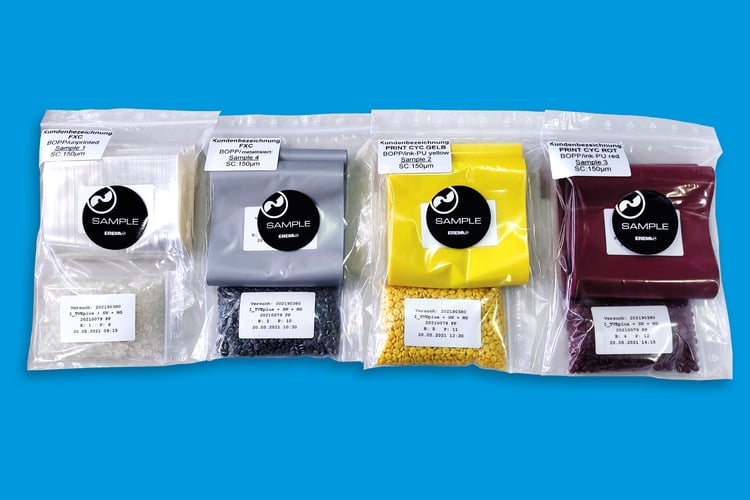New input for design for recycling guidelines
 Recycling is a central aspect of the sustainable use of packaging. So, it's no wonder that the topic also plays a major role for us. But to what extent do printing inks influence recycling? The PrintCYC initiative is looking into this very question. Launched about two years ago, the company consortium investigates the impact of printing inks on the recyclability of plastic films, the recycling process, the quality of granulates as well as their processability.
Recycling is a central aspect of the sustainable use of packaging. So, it's no wonder that the topic also plays a major role for us. But to what extent do printing inks influence recycling? The PrintCYC initiative is looking into this very question. Launched about two years ago, the company consortium investigates the impact of printing inks on the recyclability of plastic films, the recycling process, the quality of granulates as well as their processability.
Dr Lars Hancke, Business Development Manager at hubergroup Deutschland, represents our company in this initiative. In the following interview, he gives us insights into PrintCYC’s work and its latest findings.
First of all, could you please tell us a bit about PrintCYC? Who are the partners of PrintCYC and what’s the common goal?
Lars: PrintCYC started in March 2019 as an initiative of several companies within the value chain of printed films. Our aim is to drive the circular economy by conducting industrial trials on the mechanical recycling of printed polyolefin-based packaging films. Apart from hubergroup Print Solutions, the machine manufacturers Brückner Maschinenbau, Erema, and PackSYS Global as well as Profol, a producer of PP cast films, are currently engaging in the initiative. Dr Anett Karding-Koppers, an independent packaging expert and sustainability consultant coordinates the initiative.
Why do you concentrate on mechanical recycling?
Lars: Mechanical recycling is the most promising method, at least in the short term, as it is a well-established state-of-the-art technology in many countries, especially in Europe. However, the quality of recyclates from mechanical recycling is often insufficient. This is exactly where PrintCYC comes in.
What results have you found in your research so far?
Lars: In the starting phase of the project in 2019/2020, we successfully produced PP and PE films and packaging samples containing more than 50 % of recyclate from post-industrial sources. We put a special focus on the recyclability of the binders NC (nitrocellulose), PU (polyurethane) and PVB (polyvinyl butyral). Thereby, we identified the binder PU as most temperature resistant and, thus, as the best solution for mechanical recycling without deinking.
This year, we have focused our research on the impact of pigments. While inorganic pigments are mostly temperature stable and therefore supposed to be recyclable without degradation, organic azo pigments such as most standard red and yellow pigments are more temperature-sensitive and might split into critical components. In our research, we have thus examined commercially available standard pigments for flexo and gravure printing – pigment yellow 17 (PY 17) and pigment red 57:1 (PR 57:1). Both pigment types showed excellent recyclability, leading to odour-free, defect-free, and colour-stable PP recyclates. After the first recycling loop, we found that the material properties were comparable to virgin material.
Moreover, PrintCYC has partnered with the R-Cycle initiative to demonstrate how a crisp bag needs to be designed to become fit for the circular economy. [Find out more about the project here.]
What conclusions does this give for Design for Recycling Guidelines?
Lars: With regard to our initial results, printing inks should preferably be based on heat-stable binders like PU. Our latest results show that there is a wide range of reuse options in film and packaging applications for inks using standard pigments.
How have the results been received in the industry so far?
Lars: Very positively. We are in continuous exchange with brand owners and other initiatives which are very interested in these results, and we have noticed that other companies take up our results for their own products. We are pleased that we can make a real contribution to more sustainable packaging design with PrintCYC.
Find out more about the PrintCYC initiative in the INNOFORM Podcast, in which Dr Annett Kaeding-Koppers talks about the influence of inks on film recycling [only available in German].

The PrintCYC initiative produced odourless and colour-stable PP recyclates from yellow and red printed films that are comparable to virgin material. Transparent and metallised granulates served as reference materials. [Picture source: EREMA]